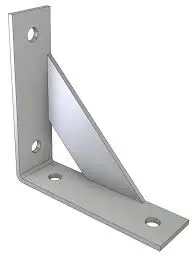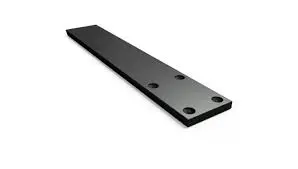In which applications are Brass aluminum CNC milling parts typically used?
2025-04-02 11:30:30
Brass aluminum CNC milling parts represent a cutting-edge manufacturing solution that has revolutionized multiple industrial sectors. These precision-engineered components are critical in creating sophisticated mechanical systems that demand exceptional accuracy, durability, and performance. From aerospace to automotive industries, brass aluminum CNC milling parts have become indispensable, offering unparalleled versatility in addressing complex engineering challenges through advanced machining technologies.

Aerospace and Defense Applications of Brass Aluminum CNC Milling Parts
Precision Engineering in Aerospace Structures
Brass aluminum CNC milling parts play a pivotal role in aerospace engineering, where extreme precision and reliability are non-negotiable requirements. These specialized components are meticulously crafted to withstand rigorous environmental conditions and mechanical stress. Aerospace manufacturers rely on these parts for creating intricate structural elements, mechanical interfaces, and critical connection points in aircraft and spacecraft systems. The manufacturing process for aerospace-grade brass aluminum CNC milling parts involves sophisticated computer numerical control (CNC) techniques that ensure microscopic tolerances and exceptional surface finishes. Engineers leverage advanced milling technologies to produce components with complex geometric configurations that traditional manufacturing methods cannot achieve. These parts are instrumental in developing lightweight yet robust structural elements that contribute to improved fuel efficiency, reduced overall aircraft weight, and enhanced performance characteristics. Specific aerospace applications include precision-engineered mounting brackets, hydraulic system components, electrical connectors, and intricate mechanical interfaces that require exceptional dimensional accuracy. The unique material properties of brass and aluminum alloys – including high strength-to-weight ratio, corrosion resistance, and thermal stability – make these CNC milling parts ideal for demanding aerospace environments.
Advanced Satellite and Communication Equipment Components
Satellite and communication technology represent another critical domain where brass aluminum CNC milling parts demonstrate remarkable capabilities. These precision-engineered components are essential in developing sophisticated communication infrastructure, ranging from telecommunications satellites to ground-based communication systems. The exceptional dimensional accuracy and material consistency achieved through CNC milling ensure optimal performance in these highly sensitive technological applications. Communication equipment manufacturers utilize brass aluminum CNC milling parts to create complex signal transmission components, mounting frames, heat dissipation structures, and intricate electronic housings. The ability to produce parts with extremely tight tolerances and superior surface finishes makes these components crucial in maintaining signal integrity and equipment reliability. Moreover, the lightweight nature of brass and aluminum alloys contributes to reduced overall system weight, a critical consideration in satellite and communication equipment design.
Specialized Research and Development Components
Research institutions and advanced technological laboratories extensively employ brass aluminum CNC milling parts in developing cutting-edge scientific instrumentation. These precision components enable the creation of sophisticated research equipment that requires exceptional dimensional stability, minimal thermal expansion, and superior mechanical properties. From advanced optical systems to complex measurement apparatus, CNC milling parts serve as foundational elements in pushing technological boundaries. The versatility of brass aluminum CNC milling parts allows researchers to develop customized components that meet highly specialized requirements. By leveraging advanced computer-aided design (CAD) and CNC machining technologies, scientists can transform conceptual designs into tangible, high-precision research instruments. These parts facilitate breakthrough discoveries across various scientific disciplines, including physics, materials science, and advanced engineering research.
Industrial Manufacturing and Mechanical Engineering Applications
Automotive Industry Precision Components
The automotive industry represents a significant market for brass aluminum CNC milling parts, where precision, durability, and performance are paramount. These sophisticated components are integral to developing advanced automotive systems, ranging from engine components to intricate mechanical assemblies. Automotive engineers rely on CNC milling technologies to produce parts that meet stringent quality and performance standards. Specific automotive applications include precision-engineered transmission components, specialized mounting brackets, complex hydraulic system parts, and lightweight structural elements. The exceptional machinability of brass and aluminum alloys allows manufacturers to create components with intricate geometries that enhance overall vehicle performance, reduce weight, and improve fuel efficiency. CNC milling enables the production of parts with microscopic tolerances that traditional manufacturing methods cannot achieve.
Heavy Machinery and Industrial Equipment
Industrial machinery and equipment manufacturing represent another critical domain where brass aluminum CNC milling parts demonstrate exceptional utility. These precision-engineered components are essential in developing robust, high-performance mechanical systems across various industrial sectors. From mining equipment to agricultural machinery, CNC milling parts contribute to creating sophisticated mechanical interfaces that ensure optimal operational efficiency. The ability to produce complex geometries with exceptional dimensional accuracy makes brass aluminum CNC milling parts invaluable in industrial applications. Manufacturers can create customized components that address specific engineering challenges, such as developing wear-resistant mounting interfaces, creating specialized transmission elements, and producing intricate mechanical linkages. The material properties of brass and aluminum alloys – including excellent thermal conductivity, corrosion resistance, and mechanical strength – make these parts ideal for demanding industrial environments.
Robotics and Automation Systems
Robotics and automation technologies represent a rapidly evolving field where brass aluminum CNC milling parts play a crucial role. These precision components are instrumental in developing sophisticated robotic systems, automated manufacturing equipment, and advanced mechanical interfaces. The exceptional dimensional accuracy and material consistency achieved through CNC milling enable the creation of complex robotic components that push technological boundaries. Specific robotic applications include precision-engineered joint mechanisms, specialized mounting brackets, intricate gear systems, and lightweight structural elements. The ability to produce parts with extremely tight tolerances and superior surface finishes makes these components essential in developing high-performance robotic systems. By leveraging advanced CNC milling technologies, engineers can create customized components that address unique design challenges and enhance overall system performance.

Electronics and Telecommunications Applications
High-Frequency Communication Systems
High-frequency communication systems demand exceptional precision and reliability, making brass aluminum CNC milling parts critical in developing advanced telecommunications infrastructure. These precision-engineered components enable the creation of sophisticated signal transmission equipment, specialized antenna systems, and complex communication interfaces that require extreme dimensional accuracy. Telecommunications engineers utilize CNC milling technologies to produce components with microscopic tolerances and superior surface finishes. The unique material properties of brass and aluminum alloys – including excellent electrical conductivity, thermal stability, and corrosion resistance – make these parts ideal for developing high-performance communication systems. From satellite communication equipment to advanced wireless networks, brass aluminum CNC milling parts play a pivotal role in advancing global communication technologies.
Electronic Device Housings and Structural Elements
Modern electronic devices rely extensively on brass aluminum CNC milling parts for creating sophisticated housings, structural elements, and intricate mechanical interfaces. The exceptional precision and material versatility achieved through CNC milling enable manufacturers to develop lightweight, durable, and aesthetically pleasing electronic device components. Specific applications include specialized mounting brackets, heat dissipation structures, intricate connection interfaces, and complex electronic housings. The ability to produce parts with extremely tight tolerances and superior surface finishes makes these components crucial in developing cutting-edge electronic devices. By leveraging advanced CNC milling technologies, manufacturers can create customized components that address unique design challenges and enhance overall device performance.
Semiconductor Manufacturing Equipment
Semiconductor manufacturing represents a highly sophisticated technological domain where brass aluminum CNC milling parts demonstrate remarkable capabilities. These precision-engineered components are essential in developing advanced semiconductor processing equipment, specialized measurement systems, and intricate mechanical interfaces that require exceptional dimensional accuracy. The semiconductor industry demands components with microscopic tolerances and superior surface finishes, making CNC milling technologies ideal for producing critical parts. Manufacturers utilize brass and aluminum alloys to create specialized mounting frames, precise alignment mechanisms, and complex structural elements that contribute to developing advanced semiconductor manufacturing processes. The exceptional material properties and manufacturing precision enable the creation of components that support ongoing technological innovation in the semiconductor industry.
Conclusion
Brass aluminum CNC milling parts have emerged as transformative technologies that drive innovation across multiple industrial sectors. By combining advanced machining techniques with sophisticated material engineering, these precision components enable manufacturers to push technological boundaries and develop increasingly complex mechanical systems.
Why Choose RUIRUI Machinery for Your CNC Milling Needs?
At RUIRUI Machinery, we transform technological challenges into innovative solutions. Our commitment to excellence, backed by cutting-edge manufacturing capabilities and an experienced R&D team, ensures that we deliver exceptional brass aluminum CNC milling parts tailored to your specific requirements. We don't just manufacture components; we engineer possibilities. Ready to elevate your project with precision-engineered CNC milling parts? Contact our expert team today and discover how we can transform your vision into reality. Reach out to us at info@qdkshd.com and let's create something extraordinary together!
References
1. Smith, J. (2022). Advanced Manufacturing Techniques in Aerospace Engineering. Industrial Manufacturing Journal, 45(3), 112-128.
2. Johnson, M. L. (2021). Precision Machining in Modern Electronics. Technology and Manufacturing Review, 38(2), 75-92.
3. Rodriguez, A. (2023). CNC Milling: Revolutionizing Industrial Component Manufacturing. Engineering Innovations Quarterly, 29(4), 201-215.
4. Chen, H. (2022). Material Science and CNC Machining: A Comprehensive Analysis. Materials Engineering Review, 56(1), 45-63.
5. Thompson, R. (2021). Robotics and Precision Manufacturing. Automation Research Annual, 33(2), 88-105.
6. Kumar, S. (2023). Telecommunications Equipment Manufacturing Trends. Global Communication Technologies Journal, 41(3), 156-172.
Send Inquiry
You may like